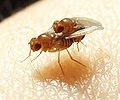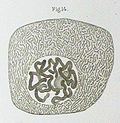Drosophila melanogaster is a species of fly (an insect of the order Diptera) in the family Drosophilidae. The species is often referred to as the fruit...
145 KB (16,709 words) - 23:27, 28 December 2024
especially the Mediterranean fruit fly. One species of Drosophila in particular, Drosophila melanogaster, has been heavily used in research in genetics and...
63 KB (6,594 words) - 20:25, 24 December 2024
organisms: Genera: Melanogaster (fungus), a genus of false truffles Melanogaster (fly), a genus of hoverflies Species: Drosophila melanogaster, a species of...
741 bytes (123 words) - 05:04, 30 January 2023
Drosophila simulans is a species of fly closely related to D. melanogaster, belonging to the same melanogaster species subgroup. Its closest relatives...
11 KB (1,182 words) - 23:08, 5 February 2024
Mushroom bodies (section Drosophila melanogaster)
americana, the honey bee Apis mellifera, the locust and the fruit fly Drosophila melanogaster. Studies of fruit fly mushroom bodies have been particularly important...
29 KB (3,400 words) - 23:32, 26 April 2024
From 1910 to 1927, Thomas Hunt Morgan's work with the fruit fly Drosophila melanogaster identified chromosomes as the vector of inheritance for genes,...
89 KB (9,334 words) - 17:14, 4 January 2025
Neurofibromin (section Drosophila melanogaster)
biology of NF1 came from model organisms including the fruit fly Drosophila melanogaster, the zebrafish Danio rerio and the mouse Mus musculus, which all...
49 KB (5,736 words) - 07:40, 25 October 2024
Achiasmate meiosis (section Drosophila melanogaster)
microtubules during anaphase I. This has been observed in budding yeast, Drosophila melanogaster, and mouse spermatocytes. Heterochromatin is a tightly grouped...
12 KB (1,334 words) - 14:21, 23 December 2024
Thomas Hunt Morgan later showed that a new white-eye mutation in Drosophila melanogaster was also sex-linked. He found that a white-eyed male crossed with...
4 KB (459 words) - 20:13, 16 September 2024
of plants. Here two examples: In the embryonic development of Drosophila melanogaster, first 13 nuclear divisions take place forming a syncytial blastoderm...
18 KB (1,935 words) - 16:21, 13 August 2024
beta-catenin, thus allowing the VEGF enzyme to solicit angiogenesis. In Drosophila melanogaster the foraging (for) gene is a polymorphic trait that underlies differences...
8 KB (825 words) - 21:37, 20 April 2023
Circadian rhythm (section In Drosophila)
PMID 352650. Konopka RJ, Benzer S (September 1971). "Clock mutants of Drosophila melanogaster". Proceedings of the National Academy of Sciences of the United...
110 KB (12,823 words) - 07:51, 24 December 2024
of the tissue but not in others, as seen in the eye of mutated Drosophila melanogaster. However, it is possible that the effect of the silenced gene is...
12 KB (1,573 words) - 06:36, 10 June 2024
developmental studies. Drosophila melanogaster was introduced into the field of genetic experiments by Thomas Hunt Morgan in 1909. Drosophila display a holometabolous...
21 KB (2,688 words) - 03:15, 29 June 2024
Ras GTPase (section Drosophila melanogaster)
with p120Ras GAP in this pathway. Expressed in all tissues of Drosophila melanogaster but mostly in neural cells. Overexpression is somewhat lethal and...
34 KB (4,040 words) - 14:34, 19 July 2024
Escargot (transcription factor) (category Drosophila melanogaster genes)
Escargot (esg) is a transcription factor expressed in Drosophila melanogaster. It is responsible for the maintenance of intestinal stem cells and is used...
18 KB (1,991 words) - 01:04, 22 June 2024
Neuroanatomy (section Drosophila melanogaster)
multitude of studies that would not have been possible without it. Drosophila melanogaster is a popular experimental animal because it is easily cultured...
38 KB (4,947 words) - 19:21, 16 September 2024
"Disruptive and stabilizing selection on the" escape" behavior of Drosophila melanogaster", Genetics, 62 (3): 625–637, doi:10.1093/genetics/62.3.625, PMC 1212303...
95 KB (10,153 words) - 20:43, 15 December 2024
Hox gene (section In Drosophila)
are similar enough to target the same downstream genes in flies. Drosophila melanogaster is an important model for understanding body plan generation and...
51 KB (6,108 words) - 02:11, 24 October 2024
William E. Castle (section Harvard and Drosophila)
suggested to Castle that Drosophila might be used for genetical work. Castle was the first to use the fruit fly Drosophila melanogaster, and it was his work...
8 KB (815 words) - 19:25, 16 September 2024
Drosophila suzukii, commonly called the spotted wing drosophila or SWD, is a fruit fly. D. suzukii, originally from southeast Asia, is becoming a major...
43 KB (4,423 words) - 09:02, 22 August 2024
have XX and others XY chromosomes (46, XX/XY). In the fruit fly Drosophila melanogaster, where a fly possessing two X chromosomes is a female and a fly...
23 KB (2,658 words) - 23:40, 28 December 2024
Ovariole (section In Drosophila melanogaster)
connect to developing ooctypes via nutritive cords. In the fruit fly Drosophila melanogaster, a common model organism for developmental research, each ovary...
5 KB (482 words) - 19:23, 16 September 2024
Morgan began to study the genetic characteristics of the fruit fly Drosophila melanogaster. In his famous Fly Room at Columbia University's Schermerhorn Hall...
38 KB (4,354 words) - 21:48, 27 December 2024
inter-locus sexual conflict are the seminal fluid proteins of Drosophila melanogaster, which up-regulate females' egg-laying rate and reduces her desire...
67 KB (8,685 words) - 21:33, 27 August 2024
White (mutation) (category Drosophila melanogaster genes)
the first sex-linked mutation discovered, found in the fruit fly Drosophila melanogaster. In 1910 Thomas Hunt Morgan and Lilian Vaughan Morgan collected...
6 KB (682 words) - 10:55, 23 June 2024
"Disruptive and stabilizing selection on the" escape" behavior of Drosophila melanogaster", Genetics, 62 (3): 625–637, doi:10.1093/genetics/62.3.625, PMC 1212303...
39 KB (3,802 words) - 20:12, 16 September 2024
Polytene chromosome (category Drosophila melanogaster genetics)
in Drosophila melanogaster in the early 1930s by German biologists Emil Heitz and Hans Bauer. In 1930, Heitz studied different species of Drosophila (D...
16 KB (1,980 words) - 00:24, 31 October 2023
conducted involving the breeding of successive generations of Drosophila Melanogaster. Genetic models predict that, in the case of mutation accumulation...
10 KB (1,279 words) - 12:20, 26 November 2024
the 2’ or 3’ oxygen; this has also been confirmed to exist in Drosophila melanogaster, zebrafish, mice, and rats. This 3’ modification is a 2’-O-methylation;...
44 KB (5,243 words) - 05:19, 29 October 2024





















